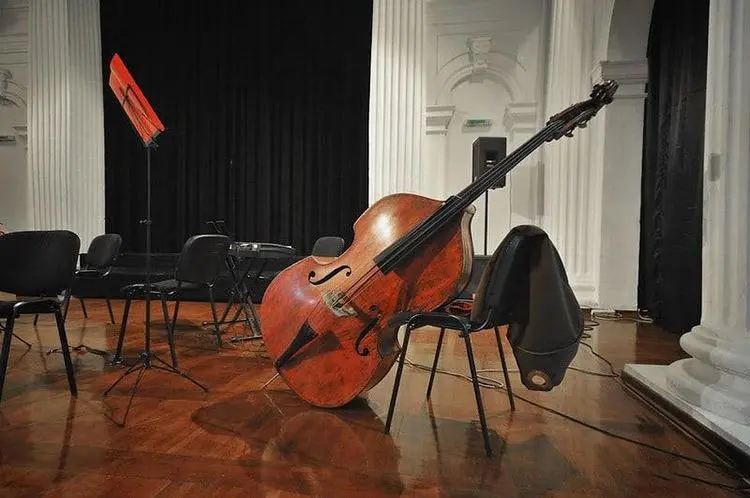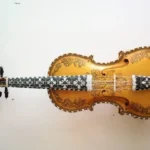
The double bass, the largest member of the string family, holds a unique and vital role in various musical genres, from classical orchestras to jazz ensembles. Known for its deep, resonant tones, the double bass provides both harmonic support and melodic lines, making it an essential instrument in many compositions. With a rich history and diverse playing techniques, the double bass offers musicians a wide array of expressive possibilities. In this overview, we will explore interesting facts about the double bass, covering its playing techniques, notation, maintenance, string materials, vibrato technique, orchestral role, and educational opportunities for aspiring bassists.
Height: The double bass typically stands about 6 feet tall when assembled, making it the largest instrument in the string family. Its considerable height gives it a commanding presence in orchestras and ensembles. The instrument’s size contributes to its deep, resonant sound, which is crucial for providing the foundational bass lines in a musical composition. The height can vary slightly depending on the specific model and design, but it generally remains within this range, allowing it to be played comfortably while standing or seated.
Weight: A standard double bass weighs between 20 to 30 pounds (9 to 14 kg). This weight is a result of the materials used in its construction, including the wood for the body and the metal for the strings. The weight can influence the player’s technique and stamina, as holding and playing the instrument requires physical effort, especially for extended periods. Musicians often customize their double basses with different fittings and adjustments to ensure comfort and balance while playing.
Strings: The double bass usually has four strings, tuned in perfect fourths: E1, A1, D2, and G2. The lowest string (E1) is tuned to the lowest pitch of any string instrument, giving the double bass its distinctively deep sound. The string material can vary, with options including gut, steel, or synthetic materials, each producing different tonal qualities. The tuning method allows for a wide range of musical expression, from orchestral performances to jazz improvisations, making the double bass versatile across many genres.
History: The double bass evolved from the viola da gamba in the late 16th century. Initially, it was used in ensembles and orchestras, gradually gaining prominence as a solo instrument. The design and construction of the double bass have been influenced by various musical styles and traditions over the centuries. Its evolution reflects changes in music preferences and performance practices, leading to the modern double bass we know today, which features a more pronounced body shape and improved sound projection.
Construction: The body of a double bass is generally made from spruce for the top and maple for the back and sides. Spruce is chosen for its excellent sound projection and tonal clarity, while maple provides durability and contributes to the instrument’s overall warmth of tone. The craftsmanship involved in constructing a double bass is intricate, requiring skilled luthiers to shape and assemble the wood to optimize acoustics. The quality of the materials and craftsmanship significantly impacts the instrument’s sound quality and longevity.
Bow Type: The bow used for the double bass is typically heavier and thicker than those used for other string instruments. This design accommodates the larger strings and the lower pitches of the double bass, allowing for a more robust sound. The bow is usually made from pernambuco wood or synthetic materials, and it features a frog that allows for precise control while playing. The heavier bow helps in producing a fuller sound and is essential for techniques like arco, where the bow is drawn across the strings to create sustained notes.
Tuning: The double bass is usually tuned an octave lower than the cello. This tuning gives the double bass its unique role in orchestras, where it provides the foundation for harmony and depth in the music. The lower tuning allows it to blend seamlessly with other instruments while still standing out in its range. Musicians often use a combination of ear training and tuning devices to ensure their instrument is accurately tuned, which is crucial for ensemble playing.
Notable Players: Famous double bassists include Gary Karr, Edgar Meyer, and Ray Brown. Gary Karr is known for his virtuosic technique and contributions to the solo repertoire for double bass. Edgar Meyer is celebrated for his versatility, blending classical and bluegrass styles, while Ray Brown made significant contributions to jazz, influencing generations of bassists. These musicians have elevated the profile of the double bass, showcasing its potential as both a solo and ensemble instrument.
Genres: The double bass is prominently used in classical music, jazz, and bluegrass. In classical settings, it often plays a crucial role in orchestral and chamber music, providing harmonic support and bass lines. In jazz, the double bass serves both rhythmic and melodic functions, often using techniques like walking bass lines. In bluegrass, it provides a driving pulse that complements the other string instruments. This versatility allows the double bass to adapt to various musical styles and contribute to different genres.
Largest Double Bass: The largest double bass ever built was made by Domenico Montagnana in 1730, measuring over 7 feet in height. This extraordinary instrument is a testament to the craftsmanship of Montagnana, who was renowned for creating high-quality string instruments. The size of the bass not only enhances its sound projection but also makes it a unique piece of musical history. The sheer height of this double bass allows it to produce exceptionally deep tones that resonate in large concert halls. Instruments of this size are rare and often seen in museums or as collector’s items, as they are impractical for most players due to their weight and handling challenges. The legacy of Montagnana’s craftsmanship continues to influence modern luthiers, and his instruments are highly sought after by professional musicians for their rich sound quality and historical significance.
Smallest Double Bass: The smallest double bass, known as the “puppet bass,” can be as small as 3 feet tall, designed for children or puppetry. This miniature version allows young players to engage with the instrument at an early age, making it more accessible and manageable. The puppet bass is often used in educational settings to introduce children to music and string instruments in a fun and engaging way. Despite its size, it retains the characteristics of a larger double bass, allowing for a similar sound quality and playing technique, albeit at a higher pitch.
Record Price: A rare double bass made by Giovanni Battista Guadagnini sold for over $200,000 at auction. Guadagnini, an 18th-century luthier from Italy, is celebrated for his exceptional craftsmanship and the quality of his instruments. The high price reflects not only the rarity of Guadagnini’s double basses but also their historical significance and the demand among professional musicians and collectors. Instruments like this often appreciate in value over time, making them not just musical tools but also valuable investments.
Orchestral Role: In orchestras, the double bass typically plays the lowest bass lines and supports harmony. It provides a foundation for the ensemble, filling out the sound spectrum and enhancing the overall richness of the music. The double bass often doubles the cello parts an octave lower, reinforcing the harmonic structure. Additionally, it plays a vital role in rhythm sections, providing a steady pulse that helps coordinate the ensemble. Its unique voice allows it to blend with other instruments while also standing out during solos or prominent passages.
Jazz Role: In jazz ensembles, the double bass often provides both rhythm and harmonic foundation. It typically plays walking bass lines, which are characterized by a steady quarter-note pulse that drives the music forward. The double bassist in a jazz setting must possess strong improvisational skills, as they frequently engage in spontaneous musical conversations with other musicians. The instrument’s ability to produce both melodic and rhythmic elements makes it essential in jazz, allowing for a dynamic interplay between the bass and other instruments, such as the piano and horns.
Fingerboard Length: The fingerboard of a double bass is approximately 41 inches (104 cm) long. This length allows for a wide range of notes to be played, facilitating the execution of both melodic lines and complex fingerings. The fingerboard is usually made of ebony, which provides durability and enhances the instrument’s tonal quality. The extended length of the fingerboard also means that double bassists must develop a unique technique for shifting positions and fingerings, often using their entire arm to reach lower notes, which is different from other string instruments.
Bridge Height: The height of the bridge on a double bass can vary but is usually around 7 inches (18 cm). The bridge serves as a critical component in transferring the vibrations of the strings to the body of the instrument, affecting its sound quality and projection. The height of the bridge can influence the string action (the distance between the strings and the fingerboard), impacting playability and tone. Adjustments to the bridge height are often made by luthiers to optimize the instrument’s response and to suit the player’s preferences.
Bow Length: A double bass bow is typically about 43 inches (109 cm) long. The length and weight of the bow are specifically designed to accommodate the larger strings of the double bass, allowing for greater control and a more powerful sound. The bow’s design enables players to produce a wide range of dynamics and tonal colors, essential for both orchestral and solo performances. The bowing technique on the double bass differs from that of smaller string instruments, requiring players to develop specific skills to manage the heavier bow effectively.
Famous Compositions: Notable compositions featuring the double bass include Bottesini’s “Gran Duo Concertante” and Hindemith’s “Sonata for Double Bass.” These works showcase the instrument’s capabilities as a solo instrument, highlighting its rich tonal qualities and technical possibilities. Bottesini, often referred to as the “Paganini of the double bass,” composed numerous pieces that are staples in the double bass repertoire. Hindemith’s sonata is recognized for its modern harmonic language and intricate interplay between the bass and piano, further elevating the instrument’s status in classical music.
Technique: The double bass can be played using two primary techniques: pizzicato and arco. Pizzicato involves plucking the strings with the fingers, allowing for a percussive and rhythmic sound that is often used in jazz and contemporary music. In contrast, arco refers to the use of a bow to produce sound, which creates a smooth and sustained tone. This technique is essential in classical music, where the double bass often plays melodic lines or harmonies. Mastering both techniques allows bass players to showcase their versatility across different musical genres.
Bass Clef: The double bass is primarily notated in the bass clef, which is essential for reading music at the lower pitch range that the instrument typically occupies. However, for higher passages, particularly in orchestral settings or advanced solo works, the tenor clef may be used. This clef allows composers to write music that is easier to read for the performer, as it places the notes in a more manageable range. Understanding both clefs is crucial for double bass players, enabling them to interpret a wider variety of musical scores effectively.
Maintenance: Regular maintenance of the double bass is vital for ensuring optimal sound quality and playability. This includes routine tasks such as tuning the strings, which can stretch and lose pitch over time, and adjusting the bridge, which affects the instrument’s action and tone. Additionally, keeping the fingerboard clean and checking for any cracks or damage is important for the longevity of the instrument. Musicians often seek the expertise of a luthier for more complex adjustments and repairs, ensuring their double bass remains in top condition for performances.
Strings Material: Double bass strings are typically made from three main materials: gut, steel, and synthetic materials. Gut strings, made from sheep intestines, provide a warm and rich tone favored in classical music but are more sensitive to humidity and temperature changes. Steel strings, on the other hand, offer a brighter sound and greater durability, making them popular in jazz and modern styles. Synthetic strings aim to combine the best qualities of both gut and steel, providing stability and a warm tone, while being less affected by environmental factors. The choice of string material significantly influences the sound and playability of the double bass.
Vibrato Technique: The vibrato technique on the double bass is characterized by a slower and wider motion compared to other string instruments, due to its larger size and string length. This technique involves oscillating the pitch of a note by rocking the finger back and forth on the string, which adds expressiveness and depth to the sound. The broader vibrato on the double bass allows for a more resonant and powerful tone, which is particularly effective in orchestral and solo performances. Developing a controlled vibrato is an essential skill for double bassists, enhancing their musical expression.
Bass Section: In orchestras, the double bass section typically consists of 4 to 8 players, depending on the size of the ensemble and the repertoire being performed. This section plays a crucial role in providing the harmonic foundation and depth to the orchestral sound. The arrangement of double basses can vary, with some orchestras opting for a more traditional setup while others may explore innovative configurations. The collaboration among bass players is vital for achieving a cohesive sound, as they often work together to blend their tones and support the overall musical texture.
Educational Institutions: Prominent music schools, such as Juilliard and Berklee College of Music, offer specialized programs for double bass performance, providing aspiring musicians with the skills and knowledge necessary to excel in their craft. These institutions feature distinguished faculty, master classes, and performance opportunities that help students develop their technique, musicality, and understanding of various styles. In addition to individual lessons, students often participate in ensembles and orchestras, gaining valuable experience in collaborative playing. The rigorous training at these schools prepares graduates for successful careers as performers, educators, and composers in the music industry.
Frequently Asked Questions About the Double Bass
General Questions
1. What is a double bass?
- A double bass is the largest instrument in the string family. It is known for its deep, resonant sound and is often used as the foundation of the orchestra.
2. How is it different from a cello?
- While both instruments are members of the string family, the double bass is significantly larger and produces a lower, deeper sound. The cello is tuned in fifths, while the double bass is tuned in fourths.
3. What is a double bass player called?
- A double bass player is also known as a bassist or a contrabassist.
4. How is the double bass played?
- The double bass can be played either with a bow or by plucking the strings. Bowing produces a smooth, sustained sound, while plucking creates a more percussive or rhythmic effect.
Learning and Playing the Double Bass
5. How difficult is it to learn to play the double bass?
- Learning the double bass can be challenging, especially due to its size and the physical demands of playing it. However, with consistent practice and proper instruction, it is certainly achievable.
6. What are the benefits of playing the double bass?
- Playing the double bass can improve coordination, rhythm, and musicality. It can also be a rewarding and fulfilling experience.
7. How long does it typically take to learn to play the double bass?
- The time it takes to learn to play the double bass varies depending on individual factors such as natural ability, practice time, and quality of instruction. However, it generally takes several years to become proficient.
8. What is the best age to start learning the double bass?
- There is no definitive age to start learning the double bass. Children as young as 8 or 9 can begin, but it is important to consider factors such as their physical development and interest in the instrument.
The Double Bass in Music
9. What types of music can the double bass be used in?
- The double bass is a versatile instrument that can be used in a wide variety of musical genres, including classical, jazz, rock, pop, and country.
10. What famous composers have used the double bass in their music?
- Many famous composers have incorporated the double bass into their works. Some notable examples include Johann Sebastian Bach, Wolfgang Amadeus Mozart, Ludwig van Beethoven, and Pyotr Ilyich Tchaikovsky.
11. What famous double bass players are there?
- There are many talented double bass players, both past and present. Some well-known names include Gary Karr, Ron Carter, and Christian McBride.
12. What is the role of the double bass in a symphony orchestra?
- The double bass provides the foundation for the orchestra, providing a deep, resonant bass line. It is often used to support the other instruments and to create a sense of stability and depth in the music.








